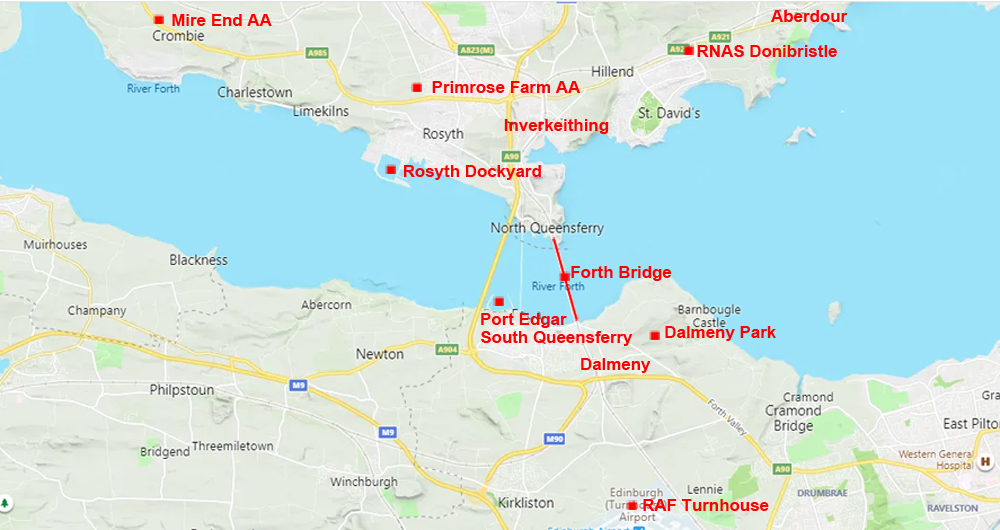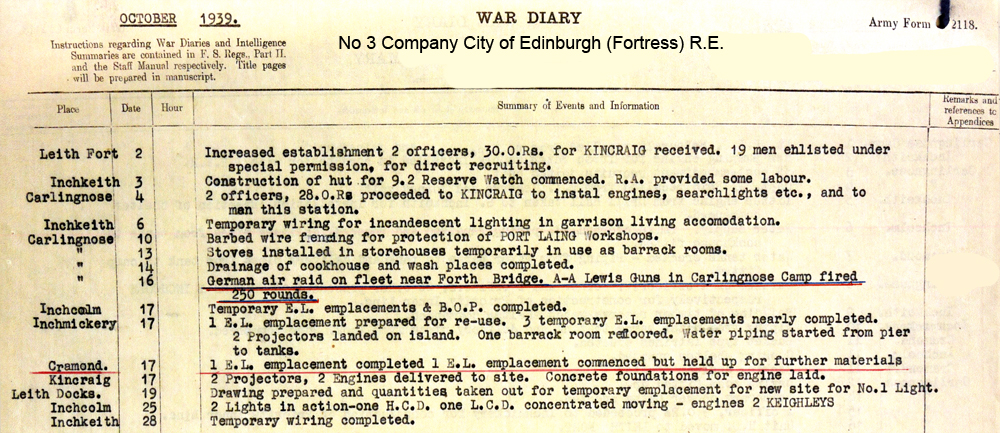First Air Raid of WWII – 19
14:38 – anti-aircraft gunners respond
| < 18 Eye-witness accounts | Δ Index | 20 2nd wave attacks > |

It was at 14.38 hours, just as the second Ju88 dived to attack, that the battery commander at the Dalmeny Park anti-aircraft unit was finally given the order to open fire. Almost simultaneously the batteries at Dalmeny village, Donibristle, Mire End and Primrose Farm barked into life, the sky filling with the white puffs of bursting anti-aircraft shells. It is significant to mention the inherent dangers that this particular form of defence brought on the inhabitants below. Within seconds a lethal deluge of hot shrapnel rained down beneath the action with consequent casualties. In addition to the antiaircraft guns of the city defences, the considerable fire power of HMS Repulse was also brought to bear.
P/O Ian Ritchie and a number of his 603 Squadron colleagues were enjoying an afternoon off in Edinburgh when the AA guns opened fire, alerting them to the fact an air raid was in progress. Eager to get back to Turnhouse and participate, the pilots dashed to their car in Frederick Street and drove at high speed back to the airfield. Unfortunately, they were too late to be of use.
As the raid began, activity in the Turnhouse operations room became frenetic. It was further hampered by the arrival of local top brass which didn’t help matters as they crowded in to see what was going on. At Turnhouse the 603 padre was about to drive to Edinburgh in order to visit P/O Graham Hunter in the military hospital in the castle. His progress was brought to a rapid halt by the sound of the air-raid siren. Clambering out of his car he ran to one of the airfield’s machine-gun posts and took charge of the Lewis gun, to the derision of the personnel.
The aircrew and ground crew had an excellent view of the diving bombers and the puffs of anti-aircraft fire. They were only three miles from the southern end of the Forth Bridge.
One of the ground crew was Jim Marshall who sought cover in an air-raid shelter with a number of colleagues: ‘I remember the day well as it was the only time I spent in an air raid shelter during the entire war!’
At South Queensferry civilian passers-by were enjoying the mild autumnal weather when at 14.30 they witnessed aircraft diving down from the west towards the shipping anchored offshore. Moments later great spouts of water confirmed the ships were being bombed.
In response the AA batteries then began to open fire.
A single Naval Fairey Swordfish was suddenly caught in the same airspace as the dive bombers and the bursts of AA gun fire. The crew were from RNAS Donibristle, Fife, and had been practising torpedo bombing in the Forth estuary off Aberdour.
John Guthrie had just turned 17 when he volunteered on 30th August 1939 to join the Territorial Army’s City of Edinburgh (Fortress) Royal Engineers Regiment at Carlingnose Camp, North Queensferry. John kept many of his personal military papers, and later tracked down his regiment’s war diaries, which include the following record: “Carlingnose – October 16 1939. German Air Raid on fleet near Forth Bridge. A-A Lewis Guns in Carlingnose Camp fired 250 rounds.”

| < 18 Eye-witness accounts | Δ Index | 20 2nd wave attacks > |